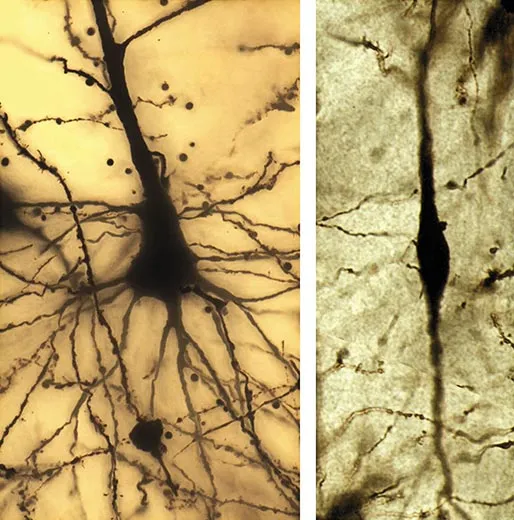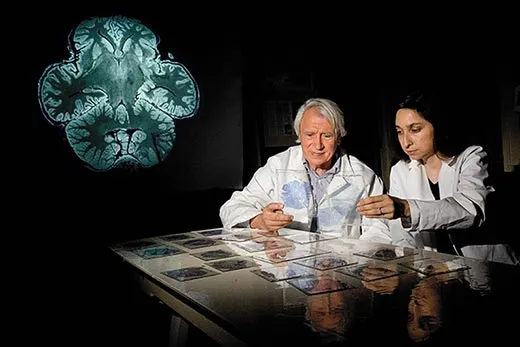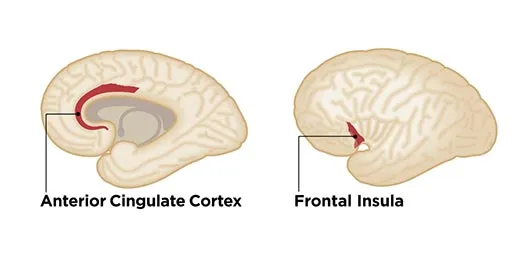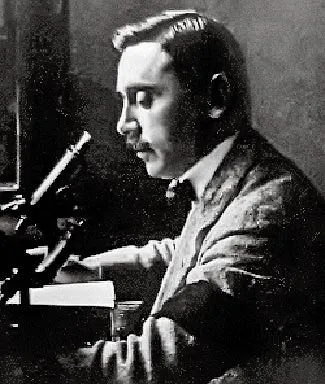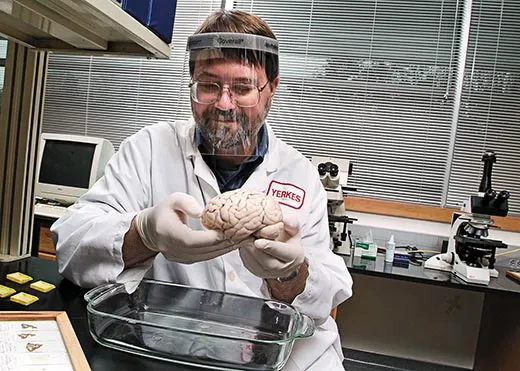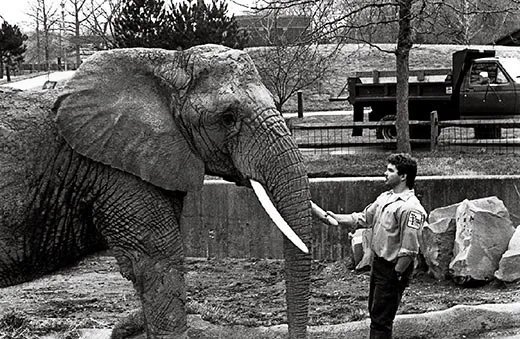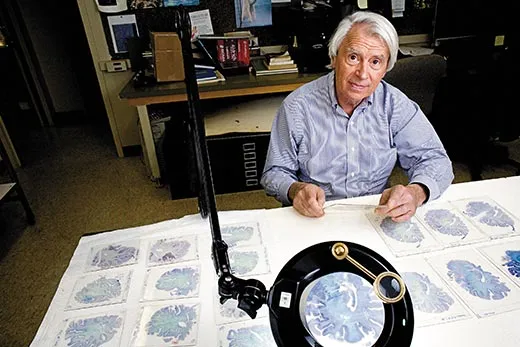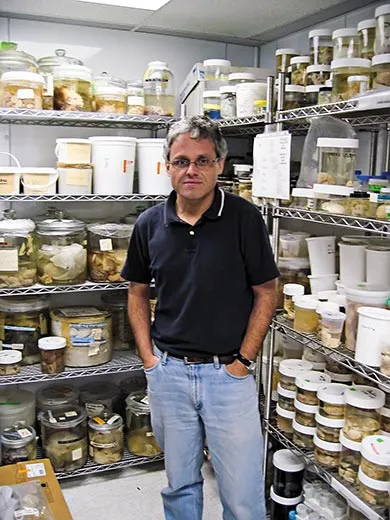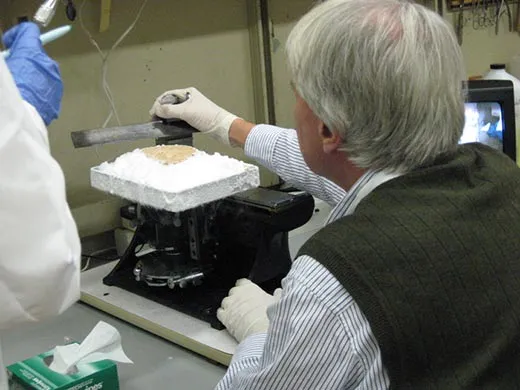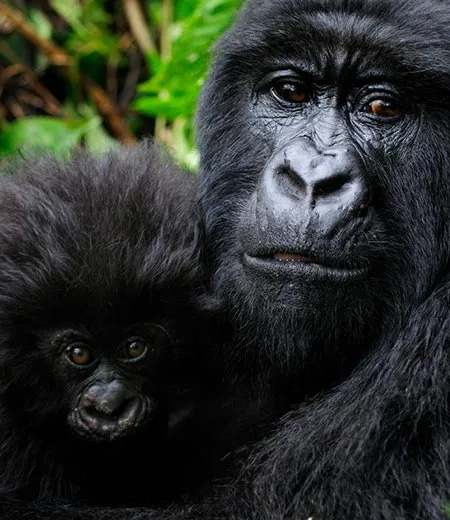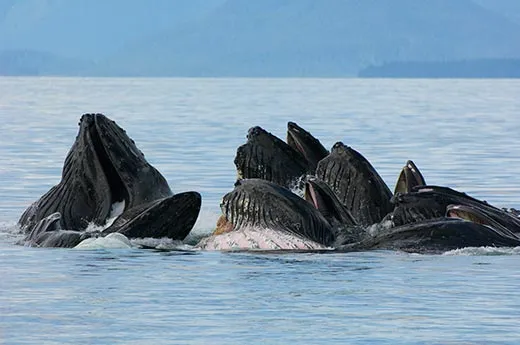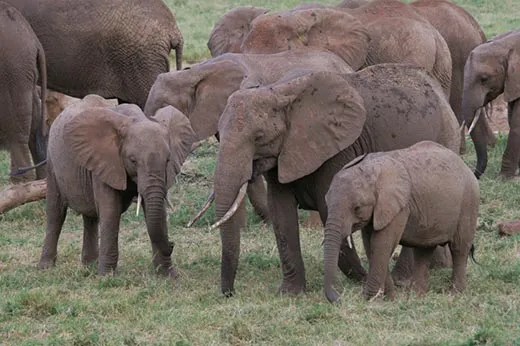Brain Cells for Socializing
Does an obscure nerve cell help explain what gorillas, elephants, whales—and people—have in common?
/https://tf-cmsv2-smithsonianmag-media.s3.amazonaws.com/filer/Allman-Hakeem-Caltech-examining-brains-631.jpg)
There was little chance of missing the elephant in the room. About a dozen years after Simba died at Cleveland Metroparks Zoo, a half-inch slab of her yellowish, wrinkled, basketball-size brain was laid out before John Allman, a neuroscientist at the California Institute of Technology in Pasadena.
Preserved in formaldehyde, it looked like half a pancake, frozen solid on a misting bed of dry ice. Allman carefully sliced it using the laboratory equivalent of a deli meat cutter. Taking well over an hour, he carved off 136 paper-thin sections.
Allman was searching for a peculiar kind of brain cell that he suspects is a key to how the African elephant—like a human being—manages to stay attuned to the ever-shifting nuances of social interplay. These spindle-shaped brain cells, called von Economo neurons—named for the man who first described them—are found only in human beings, great apes and a handful of other notably gregarious creatures. Allman, 66, compares the brains of people and other animals to gain insight into the evolution of human behavior.
"Neuroscience seems really reluctant to approach the question of what it is about our brains that makes us human, and John is doing exactly that," says Todd Preuss, a neuroanatomist and anthropologist at the Yerkes National Primate Research Center in Atlanta. "We know very, very little about how our brains differ from other animals', except that our brains are bigger."
The von Economo neurons are the most striking finding of recent years in comparative brain research, in which scientists tease out fine differences among species. Neuroanatomist Patrick Hof and his colleagues at the Mount Sinai School of Medicine in Manhattan first stumbled across the neurons in human brain specimens in 1995, in a region toward the front of the brain called the anterior cingulate cortex. Most neurons have cone- or star-shaped bodies with several branching projections, called dendrites, that receive signals from neighboring cells. But von Economo neurons are thin and elongated, with just one dendrite at each end. They are four times bigger than most other brain cells, and even in species that have the cells, they are rare.
The Manhattan team, it turned out, had rediscovered an obscure cell type first identified in 1881. Hof named the cells after a Vienna-based anatomist, Constantin von Economo, who precisely described the neurons in human brains in 1926; afterward the cells slipped into obscurity. Hof began looking in the brains of deceased primates, including macaque monkeys and great apes—chimps, bonobos, gorillas and orangutans—donated by zoos and sanctuaries. He contacted Allman, who had a collection of primate brains, and asked him to collaborate. In 1999, the scientists reported that all great ape species had von Economo cells, but lesser primates, such as macaques, lemurs and tarsiers, did not. That meant the neurons evolved in a common ancestor of all the great apes about 13 million years ago, after they diverged from other primates but well before the human and chimp lineages diverged about six million years ago.
Although Allman is renowned as a neuroanatomist, it's not surprising to find him delving into larger questions of what it means to be human. His doctorate, from the University of Chicago, was in anthropology, and he has long been fascinated with how the primate brain evolved. He conducted landmark studies with his colleague Jon Kaas, identifying the parts of the owl monkey brain that analyze visual information and make sight possible. In 1974, Allman moved to Caltech, where he studied vision for 25 years. But he also itched to uncover how the basic workings of the human brain shape social behavior. The von Economo neurons immediately captured his interest.
Allman, who is divorced, lives in a 150-year-old brick house in San Marino that he shares with two Australian shepherd dogs, Luna and Lunita. Sepia-toned photographs of his suffragist grandmother hang on the living room wall. Being "notoriously nocturnal," as Allman puts it, he rarely gets to the lab before 1 p.m., leaves in the evening to continue working at home and usually stays up until 2 a.m. His Caltech office is dimly lit by a single window and a small desk lamp; it looks like a cave overrun with books and papers. Down the hall, glass slides of gorilla, bonobo and elephant brain tissue, stained blue and brown, lie drying on tables and counters.
From von Economo's work, Allman learned that the unusual cells seemed to reside only in the anterior cingulate cortex (ACC) and one other niche of the human brain, the frontal insula (FI). Brain-scanning studies have established that the ACC and FI are particularly active when people experience emotion. Both areas also seem to be important for "self-monitoring," such as noticing bodily sensations of pain and hunger or recognizing that one has made a mistake. The ACC seems broadly involved in nearly every mental or physical effort.
By contrast, the frontal insula may play a more specific role in generating social emotions such as empathy, trust, guilt, embarrassment, love—even a sense of humor. According to experiments that measure the workings of various brain regions, the area becomes active when a mother hears a crying baby, for instance, or when someone scrutinizes a face to determine the other person's intentions. The FI is where the brain monitors and reacts to "gut feelings" from bodily sensations or interactions within a social network, Allman says. It's the link between self-monitoring and awareness of others that makes it possible for us to understand the feelings of other people. "The basic proposition that I'm advancing," he says, "is the notion that self-awareness and social awareness are part of the same functioning, and the von Economo cells are part of that."
Allman thinks that the neurons expedite communication from the ACC and FI to the rest of the brain. The cells are unusually large, and in the nervous system, size often correlates with speed. "They're big neurons, which I think do a very fast read of something and then relay that information elsewhere quickly," he says. He speculates that as our primate ancestors evolved bigger and bigger brains, they needed high-speed connections to send messages across greater distances. "Large brain size necessarily carries with it a slowing down of communication within the brain," he adds. "So one way of dealing with that is to have a few specialized populations of cells that are pretty fast."
Given that the neurons live in the brain's social hot spots, Allman theorizes that the von Economo cell system allows a rapid, intuitive read on emotionally charged, volatile situations. The neurons "would enable one to quickly adjust to changing social contexts," he speculates. In the ancient past, this neural wiring might have conferred a survival edge to our ancestors by enabling them to make accurate, split-second judgments, especially about whom they could trust or not.
Allman, Hof and their colleagues have looked for von Economo neurons in more than 100 animal species, from sloths to platypuses. Only a few of them, other than primates and elephants, are known to have the cells: humpback whales, sperm whales, fin whales, orcas and bottle-nosed dolphins. The cells presumably evolved in now extinct species that gave rise to those marine mammals some 35 million years ago.
As I watched him section the elephant brain at Caltech, Allman, with colleagues Atiya Hakeem and Virginie Goubert, finally reached the FI of Simba's left hemisphere. Three days later, microscope examination of the brain slices revealed it to be dotted with the distinctive spindle-shaped cells. That confirmed their previous sighting of similar neurons in the FI of Simba's right hemisphere. The elephant cells are larger than human and primate ones, about the size of whale neurons, but the size and shape are unmistakably von Economo neurons.
From counting the von Economo cells in 16 slides—an eye-glazing chore—Hakeem and Allman estimate that there are roughly 10,000 of them in the postage-stamp-size FI on the right side of the elephant brain, or about 0.8 percent of the FI's 1.3 million neurons. Von Economo neurons are more plentiful in the human FI, averaging about 193,000 cells and accounting for about 1.25 percent of all neurons there. In absolute numbers, the human brain has roughly half a million von Economo neurons, far more than the brains of elephants, whales or great apes. Allman and his colleagues have found none in the elephant's closest kin: the anteater, armadillo and rock hyrax. The cells' absence in these species supports Allman's theory that the neurons are a feature of big brains.
Allman speculates that such cells readily evolve from a small set of neurons in the insular cortex that are found in all mammals and regulate appetite. He thinks that while von Economo cells likely evolved to speed information around a big brain, they got co-opted by the demands of social interactions. If he's right, smart, social animals such as whales and elephants might have the same specialized wiring for empathy and social intelligence as human beings.
Whales and elephants, like people and great apes, have large brains and a prolonged juvenile stage during which they learn from their elders. They recognize one another and develop lifelong cooperative relationships. Killer whales hunt in groups and protect injured pod mates. Elephant society is anchored by matriarchs that guide their herds to watering holes they know from previous visits. (And there may be some truth to the belief that elephants never forget: when Allman, Hof and Hakeem made the first high-resolution 3-D image of an elephant brain, in 2005, they found an enormous hippocampus, the brain region where memories are formed.) The sensitive beasts identify each other by their rumblings and trumpet calls, come to each other's aid and seem to mourn their dead.
Allman likes to show a clip from a documentary about a group of African elephants that adopted an orphaned calf. When the baby elephant falls into a water hole, the matriarch quickly marches in, followed by the others. Together she and a second female use their tusks, trunks and legs to free the calf from the muck. Another animal paws at the steep bank with its foot, building a ramp the youngster uses to climb to safety. "It's really remarkable," says Allman of how the elephants rapidly sized up the crisis and worked together to save the baby. "It's a very high sort of functioning that very few animals are able to do. And," he adds with a chuckle, "humans can do it only on good days." The rescue, he says, "captures the essence of really complex, coordinated social behavior."
The idea of the neurons' centrality to social intelligence is gaining ground. Yerkes primatologist Frans de Waal says Allman's "extremely exciting" research dovetails with some of his own investigations of pachyderm intelligence. Two years ago, de Waal and two collaborators reported that a Bronx Zoo elephant named Happy could recognize herself in a mirror. Some scientists theorize that the ability to recognize one's own reflection indicates a capacity for self-awareness and even empathy, useful skills in a highly social species. De Waal points out that only animals that have von Economo neurons can do so.
Yet de Waal also cautions that "until someone establishes the exact function of those cells, it remains a story, basically."
Allman's thoughts about von Economo cells are still evolving. As new data comes in, he discards initial concepts and integrates others. Unlike the stereotypical cautious scientist, he doesn't hesitate to put forward bold hypotheses based on a few observations. The theory that von Economo neurons underlie social cognition is audacious. And it's tempting to seize upon the cells as a simple explanation for the basis of our species' complex social nature. But Allman knows that's a stretch.
His theory has its skeptics. Anthropologist Terrence Deacon, of the University of California at Berkeley, questions whether the neurons are truly a different type of brain cell or are simply a variation that arises in large brains. He says that the differences in our brains that make us human are more likely to have arisen from large-scale changes than from subtle changes in neuron shape. "I don't think it's a very big part of the story," he says of Allman's idea. Yet, he adds, when it comes to understanding the human brain, "so long as we recognize that we have so little to go on, under those circumstances all hypotheses should be entertained."
Point taken. But it's hard not to be seduced by Allman's theory when some of the most compelling evidence comes not from the animal pathology lab but from the medical clinic.
William Seeley, a neurologist at the University of California at San Francisco, studies a poorly understood neurodegenerative disease called frontotemporal dementia. Patients suffer a breakdown in their character, losing social graces and empathy, turning insensitive, erratic and irresponsible. Marriages and careers implode. Many patients seem to lack physical self-awareness: when diagnosed with other illnesses, they deny having any problems. Brain imaging studies of patients with the dementia have uncovered damage to frontal areas of the brain.
In 2004, Seeley heard Allman lecture about von Economo neurons. As Allman clicked through his PowerPoint slides, Seeley saw that the cells were clustered in the same brain regions that the dementia targeted, the ACC and FI. "It was kind of like, Eureka," Seeley recalls. He thought the cells might help researchers figure out why those areas were vulnerable to destruction. "Also, I thought, what an interesting way to learn something about human nature. Maybe the deficits that patients develop might be in things that are uniquely human. So there was a big rush of ideas."
Afterward, over coffee, Seeley and Allman agreed to team up to find out whether von Economo neurons were damaged in people with frontotemporal dementia. Analyzing brains from deceased patients, the scientists discovered that, in fact, about 70 percent of von Economo neurons in the ACC had been destroyed, whereas neighboring brain cells were largely unaffected. "It is very clear that the original target of the disease is these cells, and when you destroy these cells you get the whole breakdown of social functioning," says Allman. "That's a really astounding result that speaks to the function of the cells about as clearly as anything can."
This unusual neural system seems to underlie a lot of what makes us human. But the fact that elephants and whales apparently share the same neural hardware opens the mind to a tilt in perspective: our brains may be more similar to those of other smart, social animals than we thought.
Ingfei Chen lives in Santa Cruz, California.
Photographer Aaron Huey lives in Seattle.
